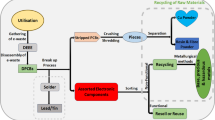Abstract
Electronic waste (e-waste) has emerged as one of the fastest-growing waste streams worldwide. Printed circuit board (PCB), the fundamental component of e-waste, is considered as a secondary resource reservoir due to its rich metallic content including base, toxic, and precious metals. E-waste recycling is necessitated for waste treatment for environmental protection as well as metal recovery for economic development. Owing to the shorter leaching time and high extraction efficiency, the chemical leaching of metals has gained momentum for metal recovery from e-waste. However, various lixiviants including strong inorganic acids and ligands used in the chemical leaching are harmful and persistent in the environment with residual effect. In this context, the present study was carried out to assess the chemical leaching of selected metals, i.e. Cu, Zn, and Ni from high-grade PCB of obsolete computer using diethylene triamine penta-acetic acid (DTPA) as an eco-friendly lixiviant with concentration varying from 0.3 to 0.7 M over a range of pH (5–9) and liquid-to-solid (L/S) ratios (10–100) at a temperature of 20 °C and mixing speed of 450 rpm. At an L/S ratio of 50 and the comminution fines in the particle size range between 0.038 and 1 mm, the maximum leaching of more than 99% each of Cu and Zn and around 81% Ni was observed in five days using 0.5 M DTPA at pH of 9. Efficient metal extraction from waste computer PCB using DTPA can be attributed to its chelating effect. These findings highlight the potential of efficient chemical leaching of metals from e-waste using DTPA as an eco-friendly organic chelator.
Access this chapter
Tax calculation will be finalised at checkout
Purchases are for personal use only
Similar content being viewed by others
References
Baldé, C. P., Forti, V., Gray, V., Kuehr, R., & Stegmann, P. (2017). The global e-waste monitor 2017: Quantities, flows and resources. United Nations University, International Telecommunication Union, International Solid Waste Association.
Choubey, P. K., Panda, R., Jha, M. K., Lee, J. C., & Pathak, D. D. (2015). Recovery of copper and recycling of acid from the leach liquor of discarded printed circuit boards (PCBs). Separation and Purification Technology, 156, 269–275.
Creamer, N. J., Baxter-Plant, V. S., Henderson, J., Potter, M., & Macaskie, L. E. (2006). Palladium and gold removal and recovery from precious metal solutions and electronic scrap leachates by Desulfovibrio desulfuricans. Biotechnology Letters, 28(18), 1475–1484.
Huang, K., Guo, J., & Xu, Z. (2009). Recycling of waste printed circuit boards: A review of current technologies and treatment status in China. Journal of Hazardous Materials, 164(2–3), 399–408.
Jadhao, P., Chauhan, G., Pant, K. K., & Nigam, K. D. P. (2016). Greener approach for the extraction of copper metal from electronic waste. Waste Management, 57, 102–112.
Li, J., Lu, H., Guo, J., Xu, Z., & Zhou, Y. (2007). Recycle technology for recovering resources and products from waste printed circuit boards. Environmental Science and Technology, 41(6), 1995–2000.
Li, J., Shrivastava, P., Gao, Z., & Zhang, H. C. (2004). Printed circuit board recycling: A state-of-the-art survey. IEEE Transactions on Electronics Packaging Manufacturing, 27(1), 33–42.
Martell, A. E., & Smith, R. M. (2003). NIST standard reference database 46. Critically selected stability constants of metal complexes database, version 7.0.
Pant, D., Joshi, D., Upreti, M. K., & Kotnala, R. K. (2012). Chemical and biological extraction of metals present in E waste: A hybrid technology. Waste Management, 32(5), 979–990.
Priya, A., & Hait, S. (2017). Comparative assessment of metallurgical recovery of metals from electronic waste with special emphasis on bioleaching. Environmental Science and Pollution Research, 24(8), 6989–7008.
Rao, S., Yang, T., Zhang, D., Liu, W., Chen, L., Hao, Z., et al. (2015). Leaching of low grade zinc oxide ores in NH4Cl–NH3 solutions with nitrilotriacetic acid as complexing agents. Hydrometallurgy, 158, 101–106.
Silvas, F. P. C., Correa, M. M. J., Caldas, M. P. K., de Moraes, V. T., Espinosa, D. C. R., & Tenório, J. A. S. (2015). Printed circuit board recycling: Physical processing and copper extraction by selective leaching. Waste Management, 46, 503–510.
USEPA. (1996). Microwave assisted acid digestion of siliceous and organically based matrices USEPA method 3052 (3rd ed.). Washington, DC: United States Environmental Protection Agency.
Wang, H., Gu, G. H., & Qi, Y. F. (2005). Crushing performance and resource characteristic of printed circuit board scrap. Journal of Central South University of Technology, 12(5), 552–555.
Zhao, Y., Wen, X., Li, B., & Tao, D. (2004). Recovery of copper from waste printed circuit boards. Minerals and Metallurgical Processing, 21(2), 99–102.
Zhou, Y., & Qiu, K. (2010). A new technology for recycling materials from waste printed circuit boards. Journal of Hazardous Materials, 175(1–3), 823–828.
Author information
Authors and Affiliations
Corresponding author
Editor information
Editors and Affiliations
Rights and permissions
Copyright information
© 2020 Springer Nature Singapore Pte Ltd.
About this chapter
Cite this chapter
Verma, A., Trivedi, A., Hait, S. (2020). Extraction of Selected Metals from High-Grade Waste Printed Circuit Board Using Diethylene Triamine Penta-acetic Acid. In: Ghosh, S. (eds) Urban Mining and Sustainable Waste Management. Springer, Singapore. https://doi.org/10.1007/978-981-15-0532-4_6
Download citation
DOI: https://doi.org/10.1007/978-981-15-0532-4_6
Published:
Publisher Name: Springer, Singapore
Print ISBN: 978-981-15-0531-7
Online ISBN: 978-981-15-0532-4
eBook Packages: Earth and Environmental ScienceEarth and Environmental Science (R0)




